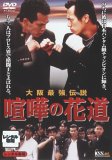| Reviews & Columns |
|
Reviews DVD TV on DVD Blu-ray 4K UHD International DVDs In Theaters Reviews by Studio Video Games Features Collector Series DVDs Easter Egg Database Interviews DVD Talk Radio Feature Articles Columns Anime Talk DVD Savant Horror DVDs The M.O.D. Squad Art House HD Talk Silent DVD
|
DVD Talk Forum |
|
|
| Resources |
|
DVD Price Search Customer Service #'s RCE Info Links |
|
Columns
|
|
|
Way to Fight, The
The film is book ended by scenes occurring in nineteen-ninety-something on the eve of a much anticipated no-holds barred match between Kazuyoshi Tamai, a street brawling boxer, and Takeshi Hamada, a karate champ. The actual bulk of the film flashes back to the 70's and explores how the rivalry began and how they grew up.
Taking on all potential rivals, Kazuyoshi was the undisputed guy to reckon with at Naniwa West High school. He and his meek best friend Toshio work at a rat infested restaurant. They each deal with their respective lack of a firm family, Toshio's father being the local weirdo, while Kazuyoshi is raised by a senile grandmother. They have a bit of a love triangle going on with childhood friend Ritsuko, who has eyes on Kazuyoshi, who in turn only thinks about fighting, while Toshio secretly longs to be more than friends with the blossoming girl who still only sees him as a friend.
When they hear word of a new kid, Takeshi Hamada, at another high school making the rounds, cleaning up the competition, a duel seems inevitable. But, a comedy of errors (which includes Takeshi believing Kazuyoshi is dead, thanks to Kasuyoshi's grandmother insisting so) makes the two miss paths. By the time they do meet, Takeshi has given up fighting after being beaten by a fourteen year old who has his own karate dojo. It will, of course, be years before they actually meet.
A male teenage dynamic is horsing around- good fun and violence merged. I remember once when two of my buddies were joking around, wrestling, punching, and aping faux martial poses. Then, one guy grabbed a baseball bat I had lying around. While intending to make a fake swing, he actually connected, bashing my other bud square on the top of the head with an audible crack. There was a pregnant, nervous, guilty pause as we waited to see if he was okay. My friend rubbed his head and simply said, "Fucker." Then, we laughed our asses off. Sure, he was hurt and we were being reckless, but it was funny. It's a testosterone thing.
The reason I tell that story is because it best sums up the mood of the film. Miike captures that unbridled side of growing up. A scene near the end of Way To Fight is a grand with an orgy of group violence and laughter, a St. Vitus melee, and it may be the most fitting scenes to describe Takashi Miike as a filmmaker.
Being a v-cinema work, done on a low budget, under the typical low budget restraints, it is a little rough around the edges. The acting, especially in the comedic bits, has a problem all too familiar with Asian comedy, forceful overacting to sell the joke. But you know, we've got Jim Carey, so we get it too. But, the film wins out on its pure endearing message of the energy of youth, the fears of maturity and finding ones way, of course tempered by Miike's black humor and goofy asides. It isn't about two guys fighting, it is about a group of kids growing up in a scrappy neighborhood and how that exuberance, their mistakes, rivalries, and their relationships will temper the rest of their lives.
The DVD: Media Blasters
Picture: Well, the back of the box states "Enhanced for 16X9 TV's", which it is not. Instead you'll find a non-anamorphic widescreen image that falls prey to the transfer stumbles of the bulk of Miike's direct to video, earlier days work. Since the bulk of the film is actually a nostalgic flashback, the visuals have a hazier desaturated look. Compression problems abound, so the transfer is laced with blocky artefacts. Again, though, it seems that most of his direct to video work suffers from similar issues, so I'll grade it on a sliding/only for Miike scale. It is watchable, just not great.
Sound: Dolby Digital 2.0, Japanese language with optional English subtitles. Again, not a high budget, glossy, super affair. The films audio mix was most likely done in a matter of days. So, it is basic, serviceable stuff. I'll say it again, it is good, just not great.
Extras: Previews for four other Miike Media Blasters DVD releases— Interview with Takashi Miike (28:51). Miike fans won't find too much they don't already know. Most of the featurette has Miike covering his start in the business and his preference for low budgets because lower expenses equals more creative control.
Conclusion: This is a case where I really like the film but I am not bowled over by the transfer. So although I am recommending the disc, those who are picky about quality may want to save it for a rental. For fans of Miike, in all of his filmmaker guises, be it the sweeter guy or the exploitative madman, it is certainly well worth owning.
|
| Popular Reviews |
| Sponsored Links |
|
|
| Sponsored Links |
|
|
| Release List | Reviews | Shop | Newsletter | Forum | DVD Giveaways | Blu-Ray | Advertise |
|
Copyright 2024 DVDTalk.com All Rights Reserved. Legal Info, Privacy Policy, Terms of Use,
Manage Preferences,
Your Privacy Choices | |||||||














